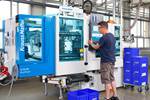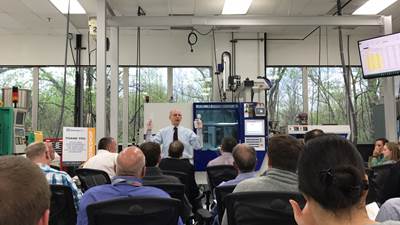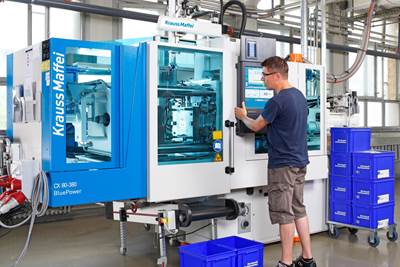Starting or Restarting an Injection Molding Machine — What Works Best?
Successfully starting or restarting an injection molding machine is less about ticking boxes on a rote checklist and more about individually assessing each processing scenario and its unique variables.

What should guide process technicians as they start or restart an idled injection molding machine? Source: Engel
Recently, I had a newly promoted process technician ask, “What is the best way to start a machine?” I told him, “I’m not sure there is a best way, but startups and restarts are when a majority of your critical failures can occur.” It is very important to know your process fully to avoid these failures. When addressing a process interruption on the machine, it’s not as simple as backing off on your shot size to avoid overpacking a mold. It’s understanding the part and mold design, and where the demolding features are located in the tool. On that point, you need to ask, ‘will a short part get stuck in the mold?’
My response wasn’t a direct, here is the step-by-step procedure on restarting or starting a machine. Instead, my answer was, “Know your overall process and you’ll answer your own question.” What works for one process, may not work for another, and many times there are factors that change how you would restart the same process. I challenged him to identify a few circumstances where restarting the same machine may require changing how he restarts it. The downtime of the process interruption was the first factor that he was able to come up with and one of the most important.
What works for one process, may not work for another and many times there are factors that change how you would restart the same process.
With downtime comes material degradation, so the longer a machine has been down, the more we may need to purge the injection unit to ensure we don’t inject degraded material into the mold. Back when I was a technician, this was classified as a “hot shot” and it typically required the mold to be pulled from the machine and the internal tool room would have to chip away the degraded plastic. If you were unlucky enough to hot shot a mold, the toolmakers would definitely remind you of it every chance they had. Cleaning a mold after it was a hot shot was time consuming and took a lot of work.
His second response was related to regrind, and again it was one of the more important factors to consider. Regrind can often lower the thermal stability of the material so that shorter downtime periods can lead to material degradation, resulting in the scenario I mentioned above.
We didn’t review every possible factor to consider, but I thought it was important to also mention process settings, and one of the first settings that comes to mind is sprue break. Sprue break is when the injection unit pulls back from the mold sprue, typically after the completion of the shot size recovery stage of the injection process. It is often used on stack molds due to the sprue bar travel, but I have used it to stop cold runner sprues from sticking or to prevent freeze-off on low-temperature molds that cool the nozzle down too much between injection cycles.
Even when your machine is equipped with a nozzle shutoff, this can decrease the volume of material that is in your process. Plastic can leak out of the sprue or the nozzle itself when the injection unit is pulled back, and when a process interruption occurs, this will intensify. You now have less plastic being injected into your mold. This may or may not be an issue, that’s why knowing your process is the most important factor in restarts and startups. I have run several molds where a short part could cause a critical failure because the part is short enough that the plastic misses the demolding features of the mold.
Avoid Complacency
It is also important to not become complacent when it comes to restarting a machine. We are all guilty of it. We are running a problematic job and the order is due the next day, so we have to muddle through parts sticking from time to time. We have been responding to the machine alarm several times and we get busy or it’s the end of our shift, so we go to the press, knock off the stuck part and restart the machine. We didn’t verify how long it had been down, and we cause a huge problem that could have been avoided if we would have just taken the few extra minutes to complete some due diligence. These are the kind of things that happen when new technicians try to do too much at once. I have a mantra I use with my teams: if you have five things to do, do three by the book and let me deal with the two that you couldn’t get to. This is my way of conveying to them: focus on the task in front of you and then move on to the next. Don’t let the circumstances overwhelm you and don’t be afraid to ask for help.
Understand the limitations of your machines, because we all know they don’t all perform identically.
My other mantra is one I have used in these articles many times: know your process. Understand the limitations of your machines, because we all know they don’t all perform identically. Know your mold and part design, and identify the part ejection features and the last areas to fill. Know your material and what percentage of regrind you are running, and know the injection molding process it’s running. This is how you determine how to start and restart your machine.
ABOUT THE AUTHOR: Robert Gattshall has more than 28 years of experience in the injection molding industry and holds multiple certifications in Scientific Injection Molding and the tools of Lean Six Sigma. Gattshall has developed several “Best in Class” Poka Yoke systems with third-party production and process monitoring such as Intouch Monitoring Ltd. and RJG Inc. He has held multiple management and engineering positions throughout the industry in automotive, medical, electrical and packaging production. Gattshall is also a member of the Plastics Industry Association’s Public Policy Committee. In January 2018, he joined IPL Plastics as process engineering manager. Contact: 262-909-5648; rgattshall@gmail.com.
Related Content
Why Shoulder Bolts Are Too Important to Ignore (Part 1)
These humble but essential fasteners used in injection molds are known by various names and used for a number of purposes.
Read MoreBack to Basics on Mold Venting (Part 2: Shape, Dimensions, Details)
Here’s how to get the most out of your stationary mold vents.
Read MoreFundamentals of Polyethylene – Part 6: PE Performance
Don’t assume you know everything there is to know about PE because it’s been around so long. Here is yet another example of how the performance of PE is influenced by molecular weight and density.
Read MoreThe Effects of Stress on Polymers
Previously we have discussed the effects of temperature and time on the long-term behavior of polymers. Now let's take a look at stress.
Read MoreRead Next
The Experience Curve and Well-Trained Process Technicians
Pairing external big picture training with internal job-specific instruction can help your process technicians meet quality expectations as well as production targets.
Read MoreUnderstanding—and Using—Decompression to Your Advantage
Decompression—aka suckback—is a very important setting on an injection molding machine. On today’s machines, molders typically get the option to set decompression before and after screw rotation/recovery. Are they using this feature to their advantage?
Read MoreIs It Time For Injection Molding Machines to be Standardized?
If you looked at four machines from four different suppliers, you’ll find four different sets of icons and terminologies, all in different layouts.
Read More














